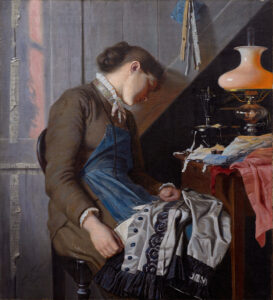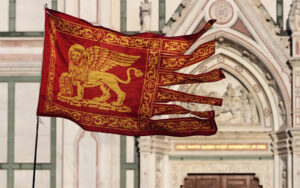Here’s your printable Convivio Book of Days calendar for May, finally! Our cover star this month is a sleepy seamstress on Whitsunday morning. She and I have a lot in common: neither of us gets enough sleep at night. If I was a seamstress, I’d be falling asleep in my work, too.
My grandmother was a seamstress and did piecework at home during the Great Depression, earning 35 cents for knitting a dozen woolen hats. Mom remembers her sewing blouses, too, during those lean years when Mom was a little girl. Grandma would sew the blouses on her sewing machine, a blouse and matching belt, and it was my mom’s job, together with her older sister, Anne, to turn the blouses right side out again when Grandma was done piecing them together. Years later, when I was a boy, Grandma made some of the shirts I wore. I wish I had them now. One of them was a pale green western style shirt (western as in American West) with pearl snap buttons and a print fabric of cowboy hats and covered wagons and horses. Another was a plaid flannel button up shirt (which no doubt set the course for the rest of my life –– someone at work once made a poster about a print we had available for purchase and it read as follows: Please inquire with anyone dressed in plaid or sporting a handlebar mustache; he was the one with the mustache, and me, I’m the one who almost always wears plaid).
Be that as it may, I imagine Grandma was sometimes a sleepy seamstress, too. She loved to stay up late into the night, which is probably the source of my own night owl tendencies. I love working in the quiet spell of night, as I am this very night. As for Whitsunday: it is another name for Pentecost, which this year comes on the 19th of May. With it, Eastertide will come to a close. It is a day that always brings to mind my friends at the Sabbathday Lake Shaker Community in Maine, for my first Whitsunday there was a very blustery one, one where the clothes on the line take on life as they billow in the breeze, and the talk at Sunday Meeting was all about Holy Spirit and Holy Ghost, about ghosts and gusts, and breath and inspiration, and all this was firing connexions through my head that took me back to Professoressa Myriam Swennan-Ruthenberg’s Italian class and the day she talked about the Italian word respiro (breath) and its root relation with ispirazione (inspiration) and I have never thought of inspiration, nor Pentecost or Whitsunday, the same since. I was dumbfounded by connexions, bowled over, and I love when that happens.
COME SEE OUR NEW SHOP!
And so it is May, well into it, and we are fast on the approach to summer. By traditional reckoning of time, in fact, summer has just begun with the month’s changing, and the next spoke on the Wheel of the Year will be midsummer, in June, around St. John’s Day. Our Grand Opening at the new Convivio Bookworks shop in Lake Worth Beach is set for that very time, so if you’re local, please mark your calendars. We’ll be celebrating on Friday June 21, Saturday June 22, and Sunday June 23. Times to be announced. It’s a magical time of the year and we will tap into that spirit as much as we can that weekend.
We’ll also be open this Saturday from 11 AM to 5 PM for last minute Mother’s Day shopping, or whatever sort of shopping you need to do. The new shop is at 1110 North G Street, Suite D, Lake Worth Beach, FL 33460. From I-95, exit 10th Avenue North eastbound; make a left at the first traffic signal onto North A Street, then at the first stop sign, turn right onto 13th Avenue North. Cross the railroad tracks and turn right again onto North G Street. We’re a couple blocks down on your left side in a blue-roofed building. Plenty of street parking on G Street and there are a few spots in our little parking lot, too.
SHOP OUR MOTHER’S DAY SALE!
Mamma loves a sale and at our online catalog right now, you may use discount code BLOSSOM to save $10 on your $85 purchase, plus get free domestic shipping, too. That’s a total savings of $19.50. Spend less than $85 and our flat rate shipping fee of $9.50 applies. CLICK HERE to shop; you know we appreciate your support immensely. And yes, you may use that $10 discount when you visit us in the store, too!
Image: “Syerske Pinsemorgen” or, in English, “Sewing, Whitsunday Morning” by Wenzel Tornøe. Oil on canvas, 1892 [Public domain, via Wikimedia Commons].


